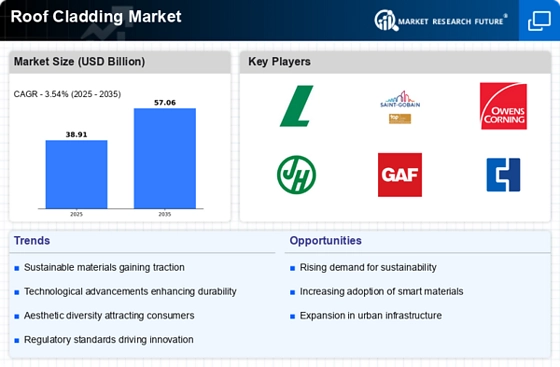Rising Construction Activities
The increasing number of construction projects across various sectors appears to be a primary driver for the Roof Cladding Market. As urbanization accelerates, the demand for residential, commercial, and industrial buildings rises, leading to a heightened need for effective roofing solutions. According to recent data, the construction sector is projected to grow at a compound annual growth rate of approximately 5.5% over the next few years. This growth is likely to stimulate the demand for diverse roof cladding materials, as builders seek durable and aesthetically pleasing options. Consequently, manufacturers in the Roof Cladding Market are expected to innovate and expand their product offerings to meet the evolving needs of the construction sector.
Growing Demand for Aesthetic Appeal
The aesthetic appeal of roofing solutions is becoming a crucial factor in the Roof Cladding Market. Homeowners and builders are increasingly prioritizing the visual aspects of roof cladding, seeking materials that enhance the overall design of buildings. This trend is particularly evident in residential construction, where diverse styles and colors are in demand. Market data indicates that the aesthetic preferences of consumers are influencing purchasing decisions, leading to a rise in the variety of roof cladding options available. Manufacturers are responding by offering customizable solutions that cater to different architectural styles. This focus on aesthetics not only drives sales but also positions the Roof Cladding Market as a key player in the broader construction landscape.
Increased Awareness of Energy Efficiency
There is a growing awareness regarding energy efficiency and sustainability among consumers and builders, which significantly influences the Roof Cladding Market. Energy-efficient roofing materials can reduce heating and cooling costs, thereby appealing to environmentally conscious consumers. Reports indicate that energy-efficient roofs can lower energy consumption by up to 30%, making them an attractive option for new constructions and renovations. This trend is likely to drive demand for advanced roof cladding solutions that incorporate reflective materials and insulation technologies. As a result, manufacturers are focusing on developing products that not only meet aesthetic requirements but also contribute to energy savings, thereby enhancing their market position in the Roof Cladding Market.
Technological Innovations in Roofing Materials
Technological advancements in roofing materials are transforming the Roof Cladding Market. Innovations such as lightweight materials, enhanced durability, and improved insulation properties are becoming increasingly prevalent. For example, the introduction of synthetic materials and advanced coatings has led to products that offer superior performance and longevity. These innovations are likely to attract builders and homeowners seeking reliable and cost-effective roofing solutions. Furthermore, the integration of smart technologies, such as solar panels and energy monitoring systems, into roof cladding is gaining traction. This trend suggests that the Roof Cladding Market will continue to evolve, driven by the need for high-performance materials that meet modern construction demands.
Regulatory Support for Sustainable Building Practices
Government regulations promoting sustainable building practices are likely to bolster the Roof Cladding Market. Many regions are implementing stricter building codes that require the use of environmentally friendly materials and energy-efficient designs. This regulatory environment encourages builders and architects to select roof cladding options that comply with these standards. For instance, initiatives aimed at reducing carbon footprints and promoting green building certifications are becoming more prevalent. As a result, the demand for sustainable roof cladding materials is expected to rise, prompting manufacturers to innovate and align their products with these regulations. This shift not only supports environmental goals but also enhances the competitive landscape of the Roof Cladding Market.





















Leave a Comment